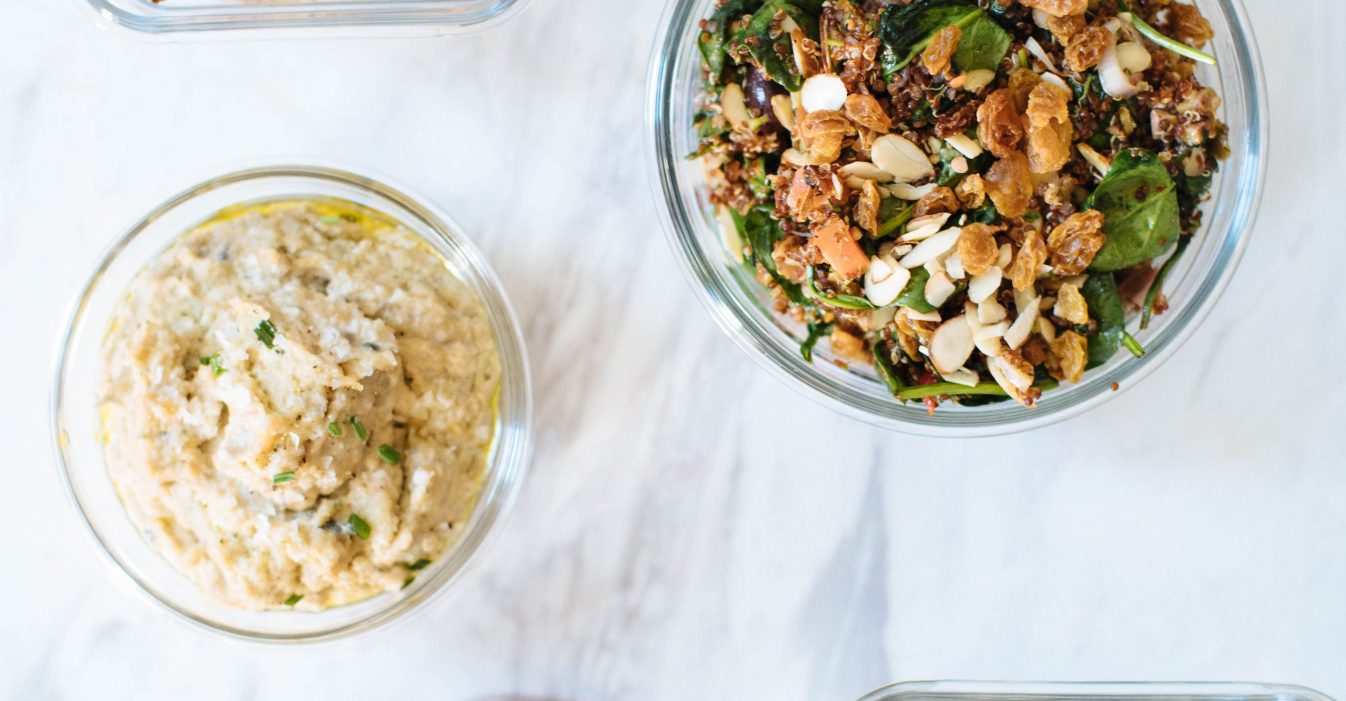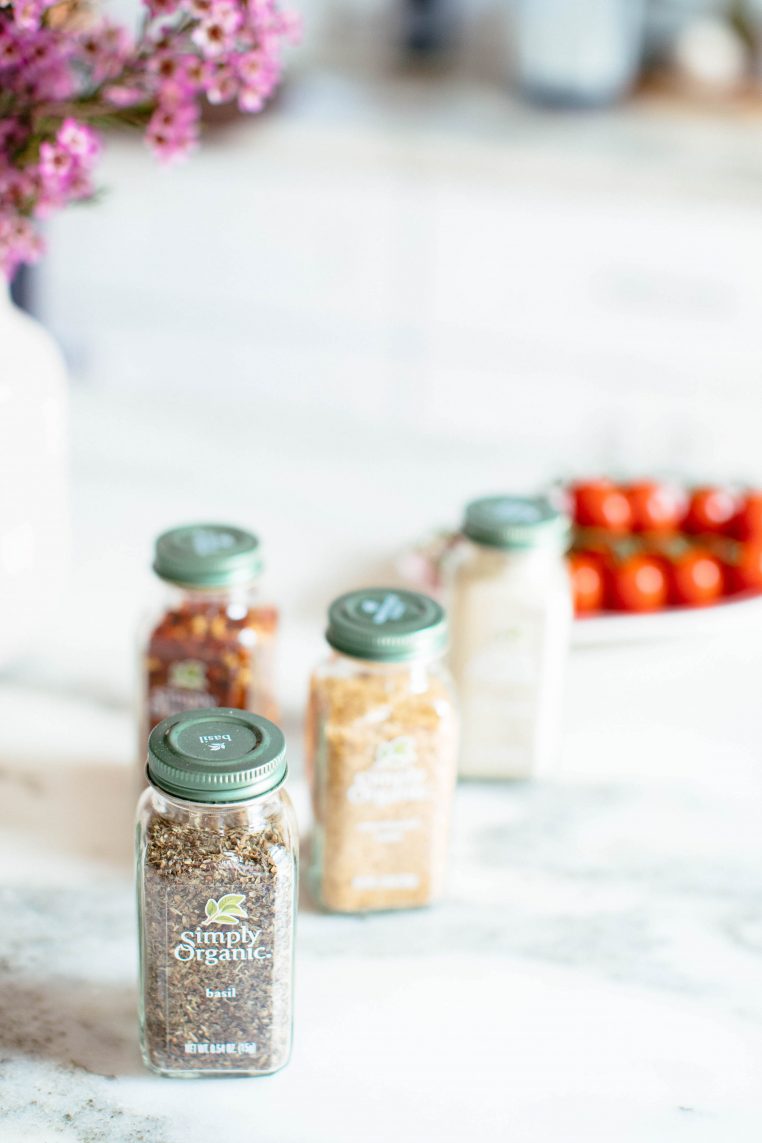It is true, healthy family meal planning costs time but, it saves even more time!
Family meal planning can seem like a huge undertaking for the already busy parent but, taking some time at the beginning of the week to organize meals and meal prep can actually save time in the long run. Whether you’re working inside or outside the home, this article will serve as a simple framework for you to plan and execute a time-saving meal plan you can reuse month after month.
As a busy, working mom of 3 and a Registered Dietitian, I know first hand that preparing healthy family meals for the week is the foundation of a happy household.
Creating a winning family meal plan everyone will love (and not losing your sanity in the process!) is a lot like putting together a puzzle. There are many strategies that will work but, its easiest to start laying the groundwork with the obvious pieces of the puzzle first like reviewing the schedule and penciling in some family favorites. As a result, you’ll have a structure to work from and the task won’t seem so daunting!
Healthy Family Meal Planning
Review the Schedule
First things first – what does the week ahead look like for you and your family? You’ll need to review the schedule to figure out where everyone will be, what activities are planned and if any meals will be eaten away from home.
Start with a simple grid for planning, electronic or on paper, give each day a column and each meal a row. Fill in any meals that won’t need to be planned like dinners out, lunch meetings, etc.
Before the grid gets filled in any further, realistically consider your family’s meal habits. For many busy families, breakfast is a quick meal eaten at home, lunch is eaten away from home at school, camp or work and the evening meal is when everyone can sit down and eat together. As a result, breakfast might consist of quick, easy grab and go or DIY items, lunch would be packed or purchased and dinner is where most of the cooking and creativity are taking place.
As you plan, this may also be a good time to prioritize at least one family meal eaten together. Research shows that eating together as a family has a number of health benefits including lower rates of obesity, better academic performance, greater self-esteem and resilience, less emotional stress and a greater sense of well-being (1).
Involve Your Roommates
Parents aren’t the only ones at the dinner table but often they are the only ones making food decisions! Therefore, to create healthy family meals that everyone will enjoy, you should get some input from your roommates (AKA everyone else that lives in the house!).
Take a poll to determine family favorites that should make a regular appearance on the menu and consider any requests to try new and different meals or snacks. If there are new recipes you’d like to try, think about using 1-2 max for the week. This way if there are any hiccups you’ll have the family favorites as anchors for the week.
Establish the Meals for the Week
The heart of a healthy family meal plan is establishing a variety of meals for the week that are both manageable to come together and appealing for you and your family. Start with breakfast and work your way through each meal.
Breakfast
For breakfast use a mix of hot and cold items that incorporate nutrient-rich foods like berries, nuts, seeds, avocados, and whole grains. Select items that are easy to put together quickly for both adults and children:
- Smoothies (try to avoid making a glorified milkshake here, low sugar smoothies are best)
- Toast with avocado or nut butter
- Muffins or bread made from whole grain or nut flours (ex. banana nut bread)
- Overnight oats
- Granola or raw-nola
- Egg muffins
Lunch
Lunches are the meal most typically eaten away from home. Incorporate fresh vegetables and fruits into the mix here, either as part of the main dish or a side dish. Some simple go-to lunches might include:
- Simple green salad (add extra protein like tofu or salmon to boost the satiety or fullness factor)
- Turkey wraps (if making ahead slice the avocado just before eating)
- Egg salad + leafy greens (spinach and arugula are great choices)
- Black bean burgers + simple slaw
- Soup (great make-ahead, one container meal)
Dinner
Dinners are typically eaten at home and are the perfect place to flex your creative muscles and spend a bit more time in the kitchen. Looking for healthy dinner ideas but don’t know where to begin?
Start by giving your evening meal some structure with a general theme for the day of the week and adding variety within that theme. Of course, you don’t have to follow the below plan exactly but, use it for inspiration and adapt to your family’s meal preferences.
- Pasta Sunday: vary the pasta and the toppings, spaghetti squash, zucchini noodles, bean or quinoa-based pasta, red sauce, pesto, etc.
- Meatless Monday: falafel, tofu curry, salad bar, etc.
- Taco Tuesday: mix up the fillings and the shells here, black bean, fish, sweet potato, corn tortillas, lettuce wraps, almond flour wraps.
- Burger Wednesdays: chickpea, salmon, chicken, portobello
- Pizza Thursday: cauliflower crust, cassava crust, red sauce, pesto, veggies – you get the idea!
- Kid’s Choice Friday: this is a great opportunity to teach kids how to balance meals. A little guidance goes a long way here. Suggest the littles pick a main dish with some protein, a vegetable, and a fruit. Let them be creative and you might find something new you like too!
- Stir Fry Saturday: cabbage, carrots, peppers, fresh and dried herbs. The end of the weekend is a perfect time to use up odds and ends that weren’t eaten during the week. Looking for some ideas? Try the 10-minute peanut stir fry, sesame cashew shrimp, or tempeh stir fry
Next up on the healthy family meal planning agenda – take stock of what you have on hand.
Complete a Kitchen Audit
Scanning your pantry and refrigerator before you make your grocery list and head to the store (or the computer if you’re ordering) will save you both time and money. Review what you have and take some time to make room for what is coming in.
Freeze any leftovers that aren’t likely to be eaten but are still good and throw away anything that is no longer edible. If you find you’ve got a lot of food waste on your hands at the end of the week check out some tips on how to meal plan to reduce food waste.
Completing a kitchen audit sounds a little scary, doesn’t it? But this does not take as much time as you think and is absolutely a necessary evil. With your meal plan in hand, you have a rough idea of what you’ll need to make your meals. Check off what you have to avoid unnecessary purchases. Don’t forget about staple ingredients like salt, pepper, spices, vinegar, oil, garlic, and flours.
For ingredients, you plan to use, make sure they are still good. Check expiration dates, inspect packages and do the smell test if you have to!
Stellar meals start with good quality ingredients so don’t skip this step. If you’re unsure, abide by the old adage “when in doubt, throw it out”. There’s nothing worse than ruining an entire recipe with a single ingredient that’s past its prime!
Make the Grocery List
I’m definitely a lover of lists so this is arguably the easiest and most enjoyable part of the whole process for me! I suggest making a grocery list on a shareable program that can be viewed by anyone who might be shopping. This way if someone adds ingredients mid-shopping trip they’ll make it into the cart without an extra run to the store.
A few busy mom hacks here that will save you time in the long run:
- Save the meal plan and the grocery list TOGETHER to reuse. Once you have a few planned weeks you can recycle the meal plan and the shopping trip with minimal effort.
- Organize the shopping list based on the layout of the store to avoid backtracking. As you trek through the store, check off what’s made it into the cart.
Get the Goods
Its time to shop! Get everything you need to execute your healthy family meal plan. You can physically go to the store to shop or to save time, order groceries for pick up or delivery.
You might be concerned that food selected by shoppers other than yourself will not be as good as the foods you might choose in person at the store. The good news here is that most stores and grocery delivery services aim to please, they’ll refund your money or send a replacement if you’re not 100% satisfied.
If you’re in person at the store, don’t forget to check the electronic shared list as you’re making your way to the checkout line. If any last-minute items are there you’ll have time to grab them without getting out of line.
Meal Prep
Get everything into the house and then its time to get organized to set yourself up for success. Depending on the family schedule, it may make sense to actually cook some foods in advance.
This is ideal for an evening when the schedule is chaotic and you’d like to save the minimal time available for eating rather than cooking.
Some foods that lend themselves well to precooking:
- soaking and cooking dried beans
- precooking grains like rice, quinoa, steel-cut oats
- roasting chicken, browning ground meat
- hard boiling eggs
- baking bread, muffins, pancakes
- soups, stews, curries
To work in more recipes and tips for meal prep and batch cooking, check out 10 steps to meal prep like a boss and batch cooking 101.
Washing and chopping vegetables or fresh herbs is another step that will save time during the week. Keep in mind that pre-cut produce does tend to go bad faster and items with high sugar content like bananas or apples will brown faster as well. I recommend cutting and washing only what you need and store in containers that reduce air and moisture exposure as this helps cut produce last longer.
Even better, up your storage game by avoiding single-use and unstable plastics. Aim for glass, ceramic or stainless steel containers whenever possible. Mason jars can be a great way to store sauces, dressings, quick breakfasts like oats or chia pudding as well as layered lunch salads.
Execute, Enjoy and Adjust
Once you’ve done the planning and meal prep, its time to cook and quite literally enjoy the fruits of your labor! Take time to enjoy, not only the food but the company at the table. Invite a conversation about the meal and the day.
If sitting down as a family is new, it may take some time to get everyone it in the habit and that’s OK. New habits take time and the family meal is one that will become a favorite over time.
As you progress through the week, take note of what worked and what could use some tweaking. Make some notes on the meal plan to help improve it for reuse. Encourage input from the family:
- What meals were a hit?
- What meals could have been better?
- Were there recipes that took too much time to make?
- Are there ingredients you could buy in bulk for added value and reduced packaging?
- Are there steps that can you do in advance to make this meal plan easier to implement during the week?
Healthy Family Meal Planning for the Win
Planning a meal for yourself let alone a family is challenging. It certainly is like putting together a puzzle, trying to piece together schedules, taste preferences, and time management.
If you’re new to meal planning you’ll notice it requires a significant investment of time and energy upfront, but the payoff is great. Not only do you save time in the long run but when you plan meals you have more control over the health of the family as a whole – and that is an investment worth making.
Get started today by posting a list in the kitchen for everyone to write their favorite recipes. When shopping day comes, use this list to start populating your meal plan.
Happy planning and of course, happy eating!












